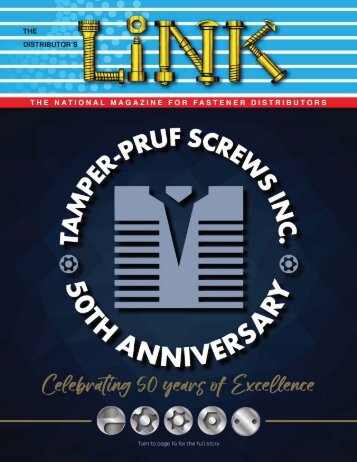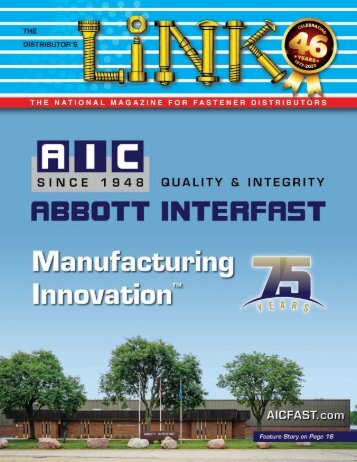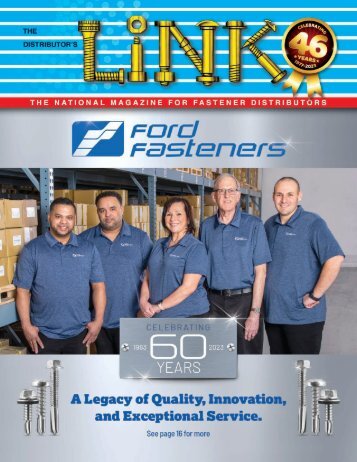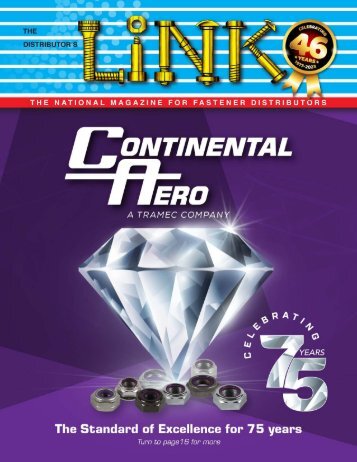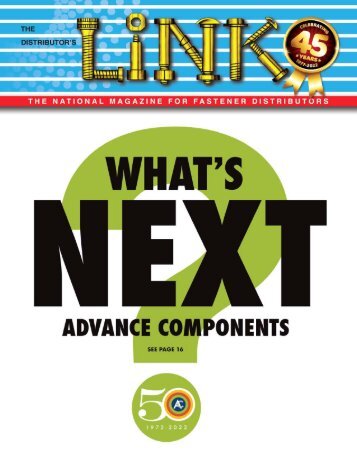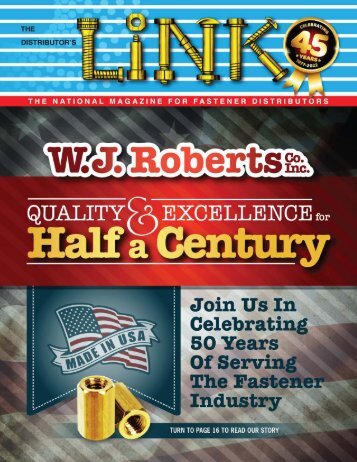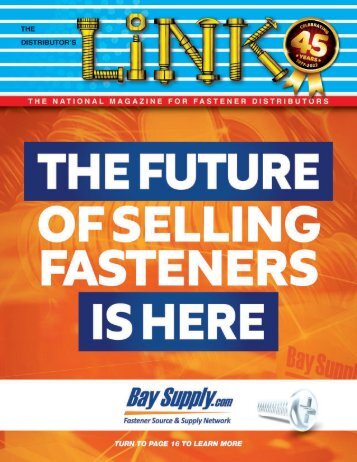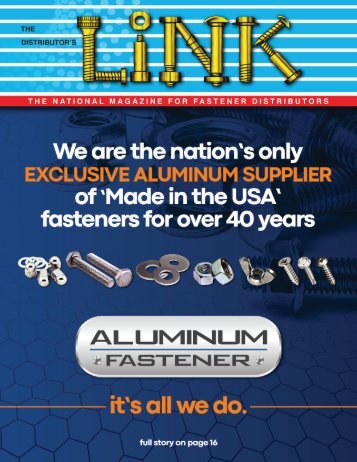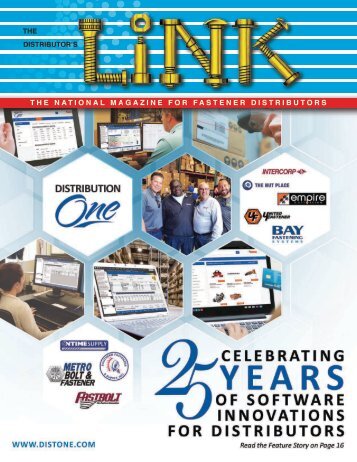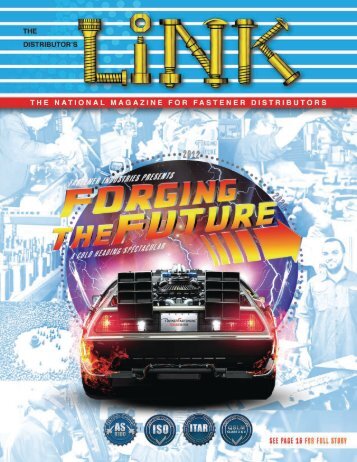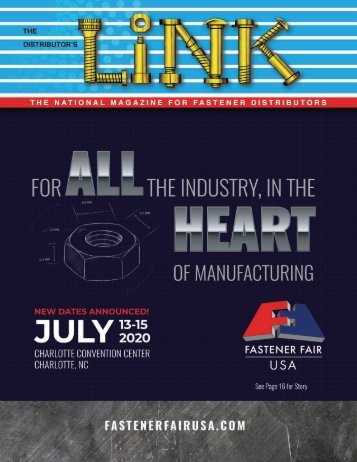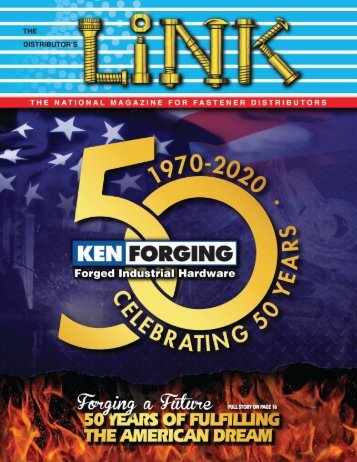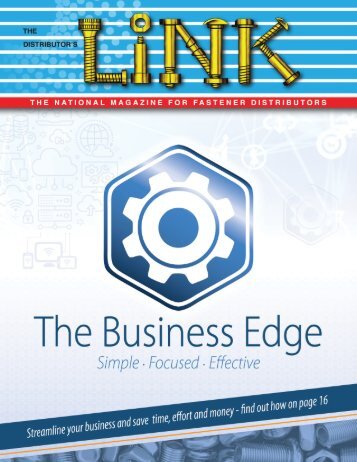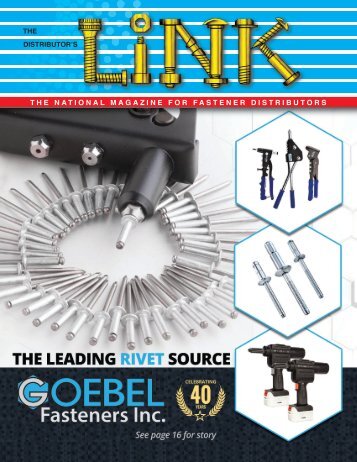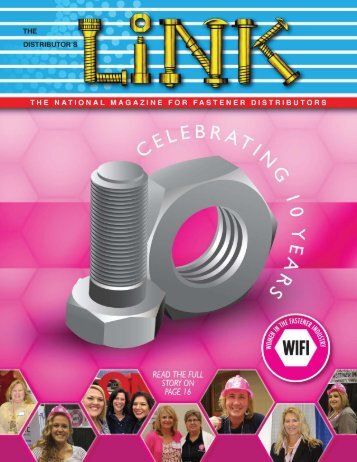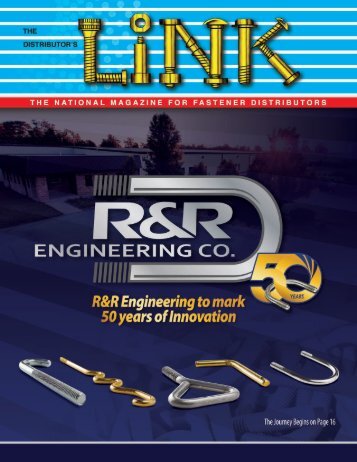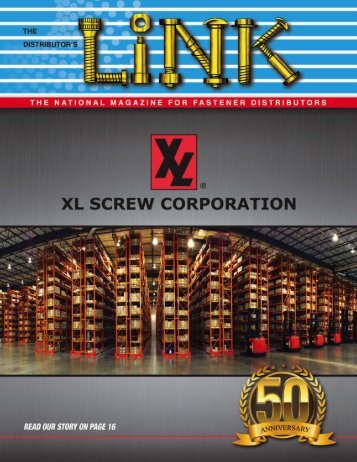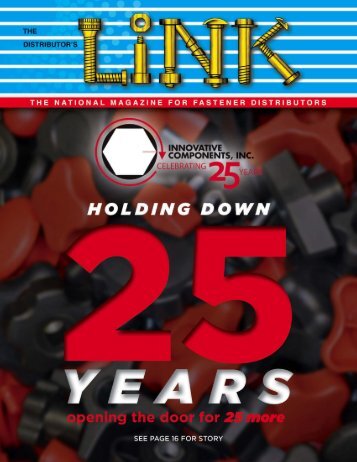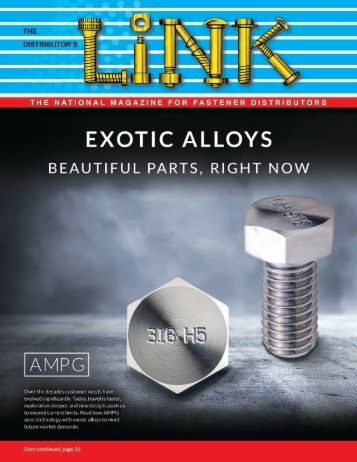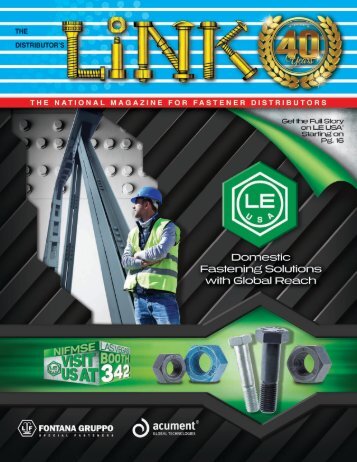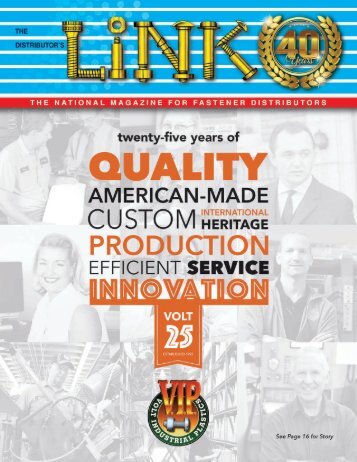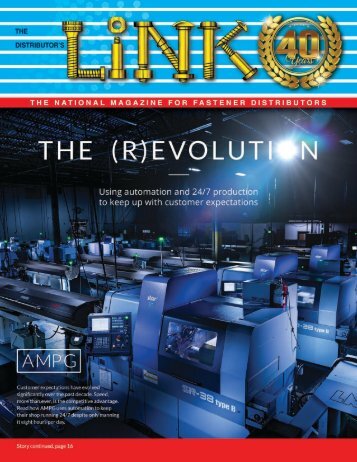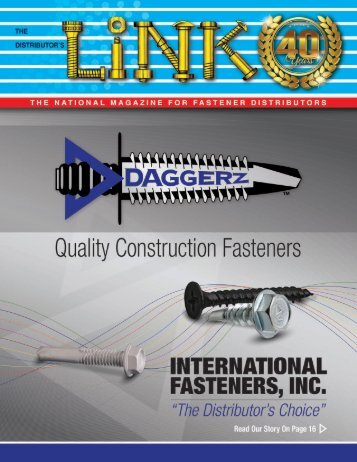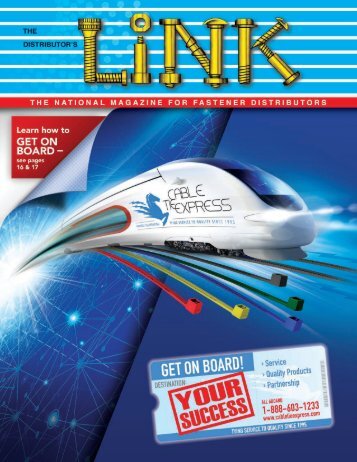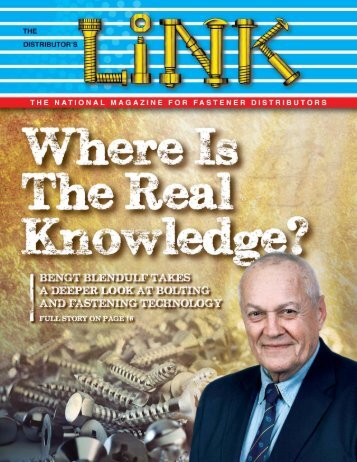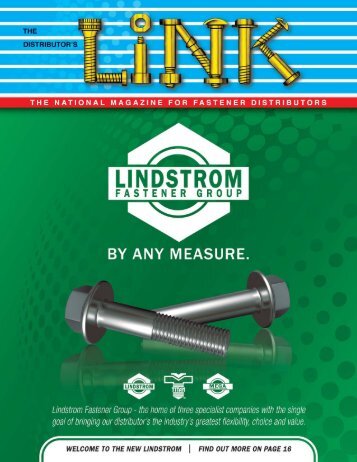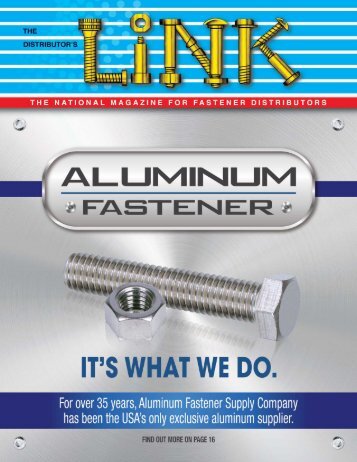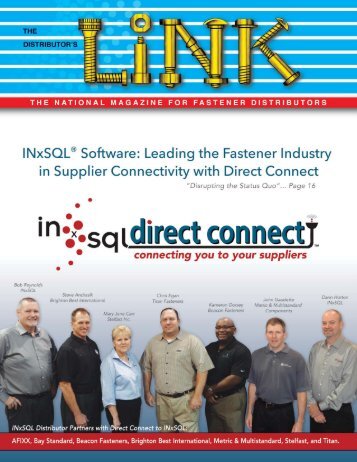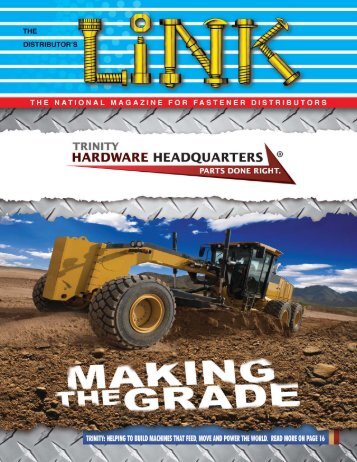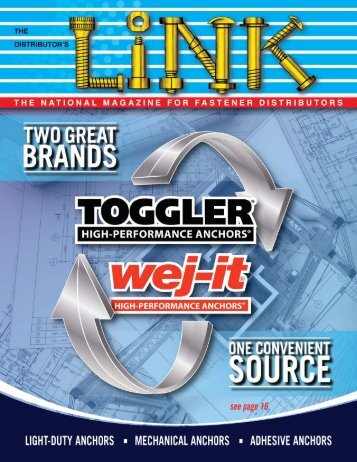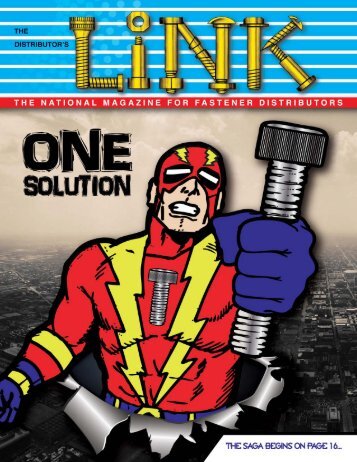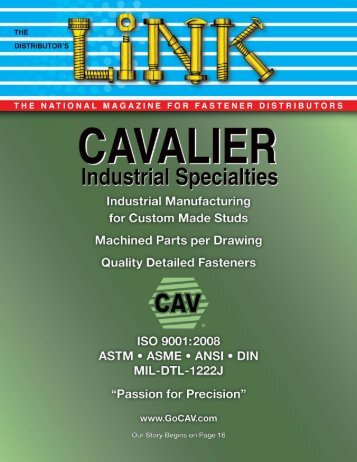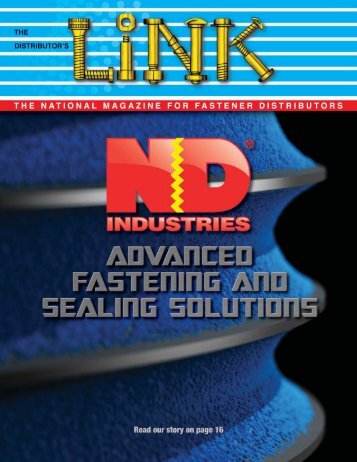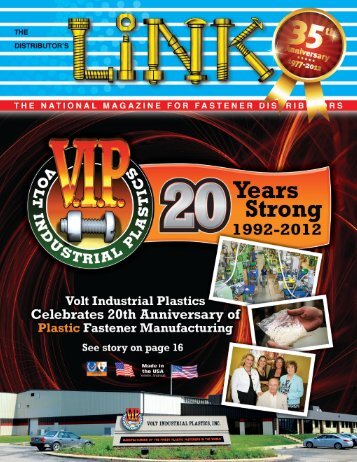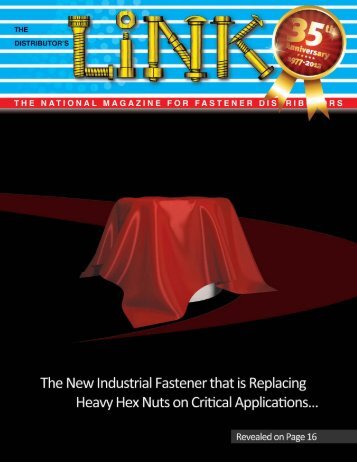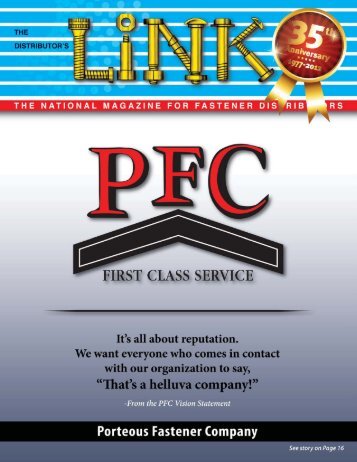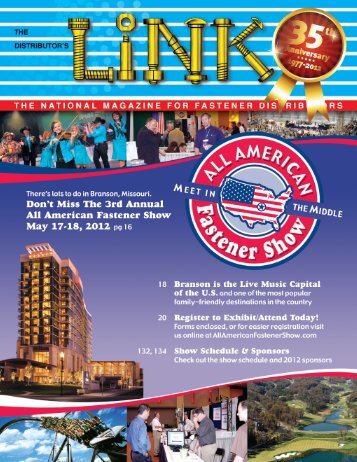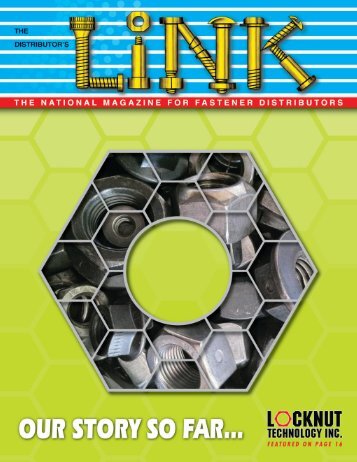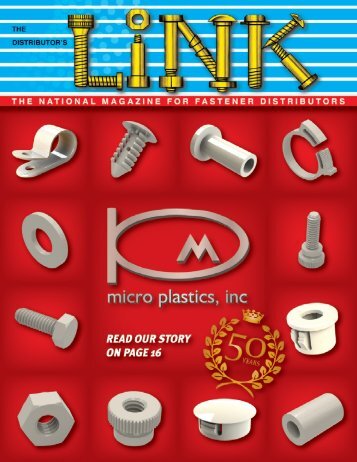SPRING 2020
- Text
- Continued
- Bolts
- Flange
- Rivet
- Distributors
- Manufacturing
- Industrial
- Products
- Fasteners
- Fastener
102 THE DISTRIBUTOR’S
102 THE DISTRIBUTOR’S LINK LAURENCE CLAUS WHY FASTENER STANDARDS ARE SO IMPORTANT from page 8 As society began to urbanize and industrialize this problem became increasingly more acute. In the early 1840’s, Joseph Whitworth, a pioneering British industrial engineer, began investigating fastener problems associated with railroad steam engines. He studied the leading London suppliers of threaded fasteners and discovered that although their product was generally uniform within their own product lines, there was little or no correlation with the neighboring competition. This led Mr. Whitworth to publish, “A Uniform System of Screw Threads”, defining the Whitworth thread form and making history as the first industrial standard. Within several years this 55° angle profile thread would become the British national thread form, accepted throughout Great Britain and the British colonies. About twenty years later, William Sellers, a United States engineer would propose the Seller’s Thread Form. This was different than the Whitworth thread form, primarily in the 60° angle profile of its thread. The Seller’s thread would quickly become the American Standard, adopted in 1868 as the US national standard and as the national standard throughout much of mainland Europe in 1898. Although multiple, competing standards are rarely an ideal situation, this was fine until world war broke out and the United States and British war machines were comingled. Since the British were using the British National (Whitworth) thread and the US were using the American National (Sellers) thread, and the two were not interchangeable, maintenance problems arose immediately. Fortunately for the Allies World War I would resolve itself relatively quickly after first experiencing these problems but rise again to greater heights during World War II. After World War II ended, leaders were committed to not let this problem occur ever again, and so a council was convened and a harmonized screw thread was established, the Unified Thread Series. As more countries adopted the Metric System, a standard for metric threads would need to be developed. The version used today, ISO 68, was developed in the early 1970s. Fastener standards fall into one of five categories; [1] Product (or Dimensional) Standards - these inform the user how to make the part [2] Material Standards - these inform the user on a material or process used to make a part or an operation such as heat treating or plating that may be conducted on a part [3] Testing Standards - often test requirements are included in the Product or Material Standard but occasionally are developed into a stand-alone document informing how the part should be tested [4] Procurement Standards - provide information about requirements the purchaser may have relative to a part [5] System Standards - these are often Quality Management System standards such as ISO 9001 and provide guidance on all aspects of structuring and running one’s business or some sub-system of a business In addition to these five different categories, fastener standards have two types, Consensus Standards and Non-Consensus Standards. Simply defined, a Consensus Standard is derived by a consensus standard organization, or one which employs the principle of open access by industry participants and experts who work together using a structured process that insures consensus of the end product. Organizations like ASTM, ASME, SAE and ISO are all consensus standards organizations. By contrast, a Non-Consensus standard is generated by a non-consensus organization, which means that the input is either not open or there is no process to make sure that the users of the standard agree to the contents. Non-Consensus Standards exist for the sole and exclusive benefit of the entity that creates them. Common examples of Non-Consensus Standards include all automotive OEM standards, MIL Standards, and OEM aircraft manufacturer standards. An important item to clarify at this point is the relationship between Consensus and Non-Consensus standards. One might like to think that there would be no relationship between the two, and occasionally this is true. More often, however, Non-Consensus Standards rely heavily on the Consensus Standards. CONTINUED ON PAGE 148
- Page 6 and 7:
in the Spring 2020 issue of 6 DISTR
- Page 8:
6 THE DISTRIBUTOR’S LINK EFC Inte
- Page 12:
10 THE DISTRIBUTOR’S LINK FCH SOU
- Page 16:
14 THE DISTRIBUTOR’S LINK Bruno M
- Page 19:
Free to all registrants is the open
- Page 24:
Continued from page 20 whose manufa
- Page 28:
26 THE DISTRIBUTOR’S LINK COMPUTE
- Page 32:
30 THE DISTRIBUTOR’S LINK Joe Dys
- Page 40:
34 THE DISTRIBUTOR’S LINK INDUSTR
- Page 43 and 44:
THE DISTRIBUTOR’S LINK 37
- Page 46:
40 THE DISTRIBUTOR’S LINK ICS FLA
- Page 51 and 52:
THE DISTRIBUTOR’S LINK 45
- Page 53 and 54:
THE DISTRIBUTOR’S LINK 47 ABLE LA
- Page 56:
50 THE DISTRIBUTOR’S LINK G.L. Hu
- Page 59 and 60: THE DISTRIBUTOR’S LINK 53 KERR LA
- Page 62: 56 THE DISTRIBUTOR’S LINK Nelson
- Page 65 and 66: THE DISTRIBUTOR’S LINK 59
- Page 67 and 68: SOLUTION INDUSTRIES LLC SOLUTION MA
- Page 70 and 71: 64 THE DISTRIBUTOR’S LINK GLOBALF
- Page 72: 66 THE DISTRIBUTOR’S LINK Morgan
- Page 75 and 76: THE DISTRIBUTOR’S LINK 69
- Page 77 and 78: THE DISTRIBUTOR’S LINK 71 NORTH C
- Page 80: 74 THE DISTRIBUTOR’S LINK ALL AME
- Page 83 and 84: THE DISTRIBUTOR’S LINK 77 G.L. Hu
- Page 85 and 86: THE DISTRIBUTOR’S LINK 79 GOEBEL
- Page 87 and 88: NFDA/PAC-WEST JOINT CONFERENCE & TA
- Page 90 and 91: 84 THE DISTRIBUTOR’S LINK SWD INC
- Page 92: 86 THE DISTRIBUTOR’S LINK YOUNG F
- Page 96: 90 THE DISTRIBUTOR’S LINK The NEF
- Page 99 and 100: SEMS AND SPECIALS INC THE DISTRIBUT
- Page 102 and 103: 96 THE DISTRIBUTOR’S LINK SOUTHWE
- Page 104: 98 THE DISTRIBUTOR’S LINK Sherex
- Page 107: THE DISTRIBUTOR’S LINK 101
- Page 111 and 112: THE DISTRIBUTOR’S LINK 105
- Page 113 and 114: THE DISTRIBUTOR’S LINK 107 TriMas
- Page 116 and 117: 110 THE DISTRIBUTOR’S LINK SALIM
- Page 118: 112 THE DISTRIBUTOR’S LINK COMPUT
- Page 121 and 122: THE DISTRIBUTOR’S LINK 115
- Page 123 and 124: NFDA/PAC-WEST JOINT CONFERENCE & TA
- Page 125 and 126: THE DISTRIBUTOR’S LINK 119 The Sp
- Page 128 and 129: 122 THE DISTRIBUTOR’S LINK STAFDA
- Page 130: 124 THE DISTRIBUTOR’S LINK ICS FL
- Page 133 and 134: NFDA/PAC-WEST JOINT CONFERENCE & TA
- Page 135 and 136: THE DISTRIBUTOR’S LINK 129
- Page 137 and 138: THE DISTRIBUTOR’S LINK 131
- Page 140 and 141: 134 THE DISTRIBUTOR’S LINK AMI KA
- Page 142 and 143: fastenerlinks THE DEFINITIVE WEB DI
- Page 144 and 145: fastenerlinks BRINGING YOU THE FAST
- Page 146: fastenerlinks BRINGING YOU THE FAST
- Page 149 and 150: THE DISTRIBUTOR’S LINK 143
- Page 152 and 153: 146 THE DISTRIBUTOR’S LINK SFA A
- Page 154 and 155: 148 THE DISTRIBUTOR’S LINK LAUREN
- Page 156 and 157: 150 THE DISTRIBUTOR’S LINK BRUNO
- Page 158:
152 THE DISTRIBUTOR’S LINK SALIM
- Page 161 and 162:
Rotor Clip Company Inc. announced t
- Page 164 and 165:
158 THE DISTRIBUTOR’S LINK ROBERT
- Page 166:
160 THE DISTRIBUTOR’S LINK NELSON
- Page 170 and 171:
164 THE DISTRIBUTOR’S LINK BRUNO
- Page 172:
NFDA/PAC-WEST JOINT CONFERENCE & TA
- Page 176:
advertisers index # 3Q, INC. 143 Fl
- Page 180:
advertisers index I INDUSTRIAL FAST
Inappropriate
Loading...
Mail this publication
Loading...
Embed
Loading...
|
SHARE A PAGE FROM THIS MAGAZINE OPTION 1: Click on the share tab above, or OPTION 2: Click on the icon (far right of toolbar) and then click on the icon (far right of toolbar) and then click on the  icon (top right of the page). icon (top right of the page).
|
View Archives
Copyright © Distributor's Link, Inc. All Rights Reserved | Privacy Policy







